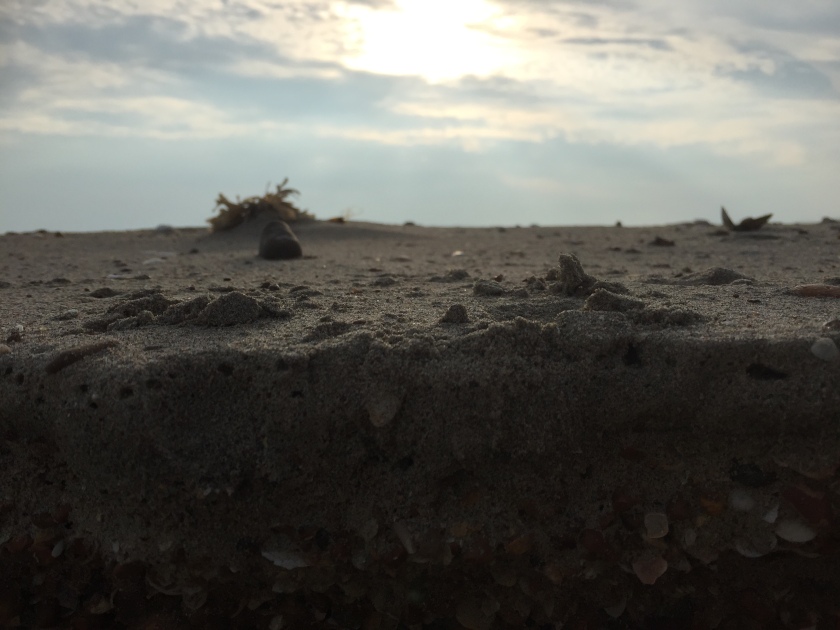The Quest.
Fractured sleep, battered and tossed in the storm of dreams, at sea. Dreamt I was stumbling about on a sandbank, looking for something or someone who eluded me. I woke up in a panic, like a landed fish , agitated, my head full of the dream images, struggling to make sense. Lying in the dark, I heard a voice distant and deep inside me, speaking with quiet authority, stating the rules of the quest. I listened, in a trance, strangely calmed. As the voice became more distant I reached for my pen and wrote down as much as I could remember. I think there was far more, I even felt that the voice was still intoning somewhere out of my hearing.
This is the challenge, accept it if you desire.
What you seek is to be found within the tides, on the sands of Pegwell, of Sandwich, and of Goodwin. Use only what can be found in these sands for your quest.
Fetch Goodwin water in a sieve. Convey it in a wagon with no wheels, in a boat with no keel. Contain the water in vessels of Pegwell mud, dug with no spade. Paint the sands with the ink of the sea. To tie the winds, bind Sandwich stones in knots, and make a rope of Goodwin sand. Let three tides pass over it.
Then you will see what is hidden. You will gain mastery of the tides. You will acquire charms to enchant or to drive away as you will. Your way will be clear.
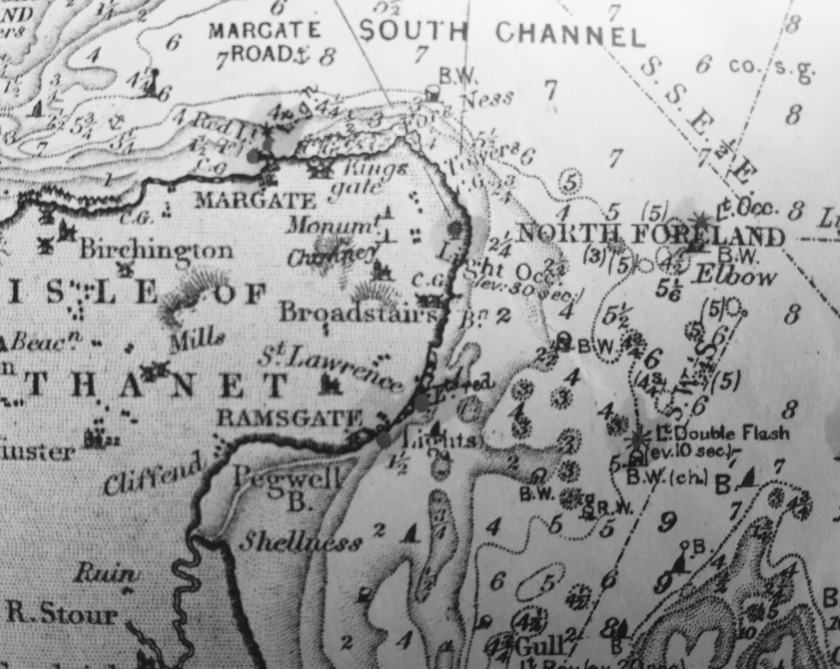
Pegwell Bay 1.
Scouring the bottom of the cliffs for Darwin’s fossils. The dazzling white of the chalk around me is echoed by the egrets moving busily through the samphire marshes, their eerie cries breaking into my reverie: the purity of this palette disrupted by the muddy debris of seaweed tangled rubbish and the stench it exudes. Sanitary plastics and rusting metal intermingled with weathered brick and old pottery shards. At the abandoned hover port, by the forlorn staircase and bridge to nowhere, there is a wilderness of what was once standard municipal planting: conifers, roses, buddleia, camomile and fennel intermingle incongruously in a wild cacophony. Overhead the parakeets are screeching and complete the dystopian panorama before me.
Pegwell Bay 2.
We walk across the bay to the sea. On our horizon we can see a line of cable and men working. The mud is dense and sucks at our feet: we do not have boots on, so now we sport muddy leggings and saturated shoes. The men still seem way off but we keep trudging warily through the mud towards a chair positioned close to a section of cable. Empty. Canute has been successful in turning back the tide here: in the opalescent light the sea seems as though it is a mirage and is far, far away.
Finally, a workman comes over, curious as to why we have trailed out this distance in the mud. He is not working on the archaeological excavation we had hoped we would find here. It is the last stage in the laying of a power line being connected to England from Belgium, a new invader in the succession of those who have landed here. We thank the workman, and turn and head back to the beach.
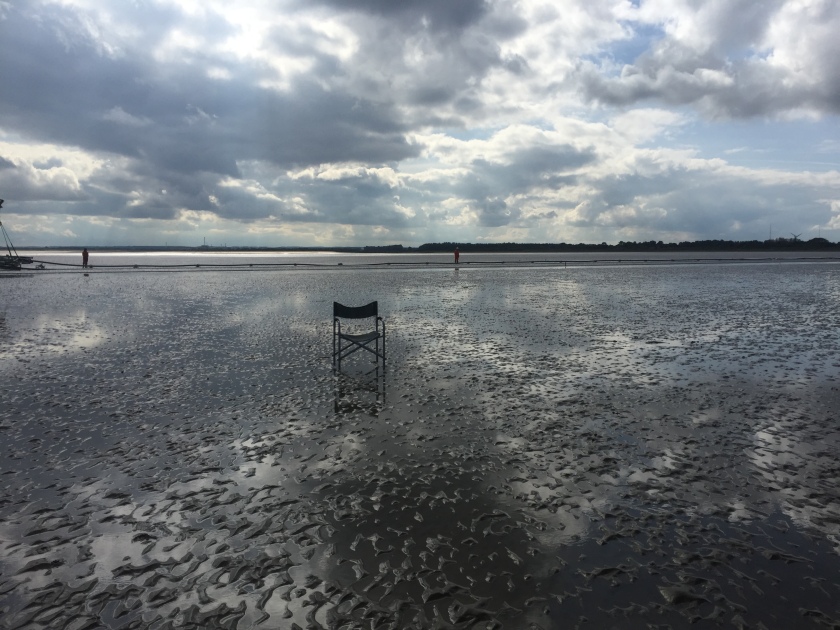
Pegwell Bay 3.
I had parked up by the Viking Ship and a couple walking their dog helped me carry the sledge down the steps onto the Hover Port tarmac. I suspect they soon regretted this act of generosity, as it was so awkward manhandling it down the narrow steps, and it seemed to get heavier by the second. The Viking ship and the ghosts of hovercraft watch over my struggles with my sledge, another obsolete mode of travel. I dragged it onto the sands and it almost seemed to glide on their firm, dry surface: but as I wade out into the mudflats the sledge starts to sinks and stick, as do my feet. When I look back at my footprints they have an odd optical effect in the sunlight and look as though they are turned out of, rather than into, the mud.
I decide that this is as close as I want to go to discovering the “treacherous bogs” in the guide to Pegwell Bay. I take the tools I made at Sandwich Bay out of my box and scoop up small quantities of the mud. It is mid to dark brown for a few centimetres, then below becomes thick, black and treacly. In places it seems like a rich tarmac and I hope this is what it is rather than anything less pleasant, which its strong smell suggests it might be. I place it in my box. I decide that was enough as the challenge didn’t state how much mud I needed. I sit on the sledge for a few minutes, catching my breath and watching an oyster catcher, marvelling at the length of its beak. then I stir myself to begin my slow way back across the flats.
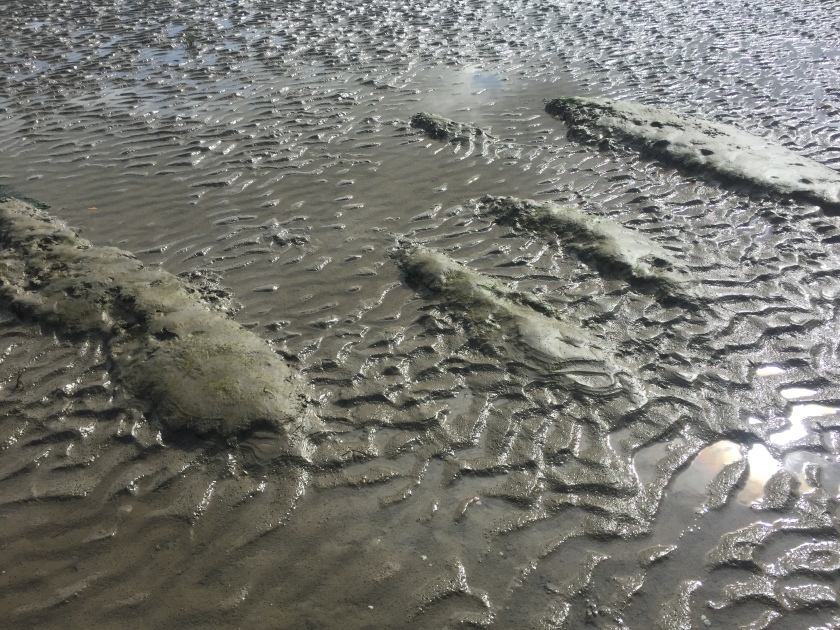
Goodwin Sands 1.
On the Lady Grace. We circle the Terschelling so that Jason the cameraman can fly his drone and get better documentation than he did on the approach. The boat sways gently, at ease with itself, the captain joking with the archaeologists’ two boys, unperturbed by our location above the Ship Swallowers. Jason is finished, Caroline catches the drone and it is packed away. We move off. The waves hitting the Sands seem to glitter more than the sea elsewhere, there is a silver quality to the water, punctuated by dark dots denoting the heads of seals bobbing up and ducking under the water. Gannets fly alongside us and the water surf flies up exhilaratingly as the captain accelerates away from the Goodwins. We strain to see the last suggestion of sandbanks and return to the cabin where the archaeologist shows us the plastic bag she is holding; it contains silver coins retrieved from the Rooswijk.


Goodwin Sands 2.
Back on the Lady Grace. Matt, the captain, looks doubtfully at the sledge on the quayside. I assure him we can lift it on and off without jeopardising his boat. We heave it aboard. The boat rocks and Matt grimaces. I inwardly curse the sledge’s weight and unwieldiness.
The sea is calm and we make good progress. I sit in the cabin with Matt, and watch the map readings on his screen. The Goodwins appear, and I feel excited and apprehensive. I am amazed at the extent of the sands, and their emptiness. Matt steers into the shallows and drops anchor. He tells me I have an hour and a half and I clamber out of the boat, jumping unsteadily into the water. Boots submerged, but the sand is firm beneath my feet.
Matt pushes the sledge over the boat towards me and I pull it awkwardly down onto the sand. He then passes me my boxes and basket, and I pile them onto the sledge and haul it away, self-conscious in his gaze, aware that I must look ridiculous.
The adrenalin of having arrived at my destination kicks in. An odd elation. The sands stretch out before me, sand lapped all around by sea. And it is seal land: the domain of those who can exist in both elements. But I cannot be distracted by the seals today.
The sledge is heavy and cumbersome: but my determination to reach the far tip of the North Brake, the closest point of the Goodwins to Pegwell, energises me, and the sands are enchanting. There is a watery sheen in areas, residual tide, which reflects the sky so I am walking in the sea, in the sky….shifting spaces. Submersion, emersion. I pull with renewed vigour and after 15 minutes arrive at what I believe to be the west end of the Brake.
I pull out my sheet from a box. I will draw the sands. I pour cuttlefish ink on the sheet, and blot the sands with the sheet. Ghostly impressions appear, marking the rhythms caused by tide lines. I take my tools and excavate sand, scooping it frantically in the small quantities my ill formed implements allow. The sand seems finer than usual, softer and devoid of shell fragments and stones.
Finally I scoop sea water awkwardly into my tiny clay vessels, nestling in the lumpen basket I found at Sandwich Bay. I realise it is easier to wade into the sea slightly to fill them but as I start doing this a tremor of fear suddenly runs through me. I think of Arthur Durham Divine’s German sabboteur, left marooned on the Goodwins watching the boat disappear, the boat he had commandeered to sail him to Belgium. I check my watch. I am in good time, but I now urgently want to be back on the Lady Grace.

Sandwich Bay 1
On my way to the beach, walking down the track past New Downs Farm. The last farm before the Bay. On my phone I have a copy of the photo of my great, great grandfather, James Smith, on horseback, herding a flock of sheep, in front of the farmhouse. The building is almost unchanged and even now there is a small flock of sheep in the adjacent field.
James Smith farmed here in the early part of the twentieth century, and he was a renowned horse rider. Family history holds that he used to gallop across the bay each day on the huge horse he is astride in the photo. It is said that he used to ride the beast into the sea and that it would swim: if the current was favourable they would go in the sea as far as the river mouth, a considerable distance. James Smith apparently could not swim himself, but had such faith in his horse ‘s abilities he would entrust himself to the sea in this way. My grandmother said that the horses at New Downs were of Lomean stock, and given the chance, would swim back there.
Lomea. The third island, mapped by the Romans, a supposedly fertile island until it was consumed by the sea when Earl Godwin failed to pay for sea defences in the eleventh century. References to this submerged island continued through the centuries, re-ignited by Charles Lyell’s excavation of the Goodwins in 1817 when he found London clay on a layer of chalk, convinced this was evidence of a former land.

Sandwich Bay 2
Thinking about other family relationships with this stretch of the coast. Samuel Pearce, my grandmother’s grandfather, a Dover fisherman, was in one of the boats accompanying Captain Matthew Webb’s swim across the Channel, holding a lamp to help guide the swimmer’s way. The route went north from Dover towards the south Goodwins before veering across to France.
Or Fred, my father’s grandfather, a milk lad at Chilton, the farm on the cliffs above Pegwell, lodging in a room looking out to sea with a view of the Goodwins and the Bay.

Sandwich Bay 3
Tool making. I find odd pieces of cloth and weathered leather shoe soles, but they don’t inspire me. They are not the barnacle encrusted oddities or fractured plastics I had hoped for. A triangular flint catches my eye- a prehistoric axe? It is lying touching a piece of sea smoothed wood. An arrow, pointing at the sea, pointing at possibilities. I pick the pieces up and walk in the direction it marked.
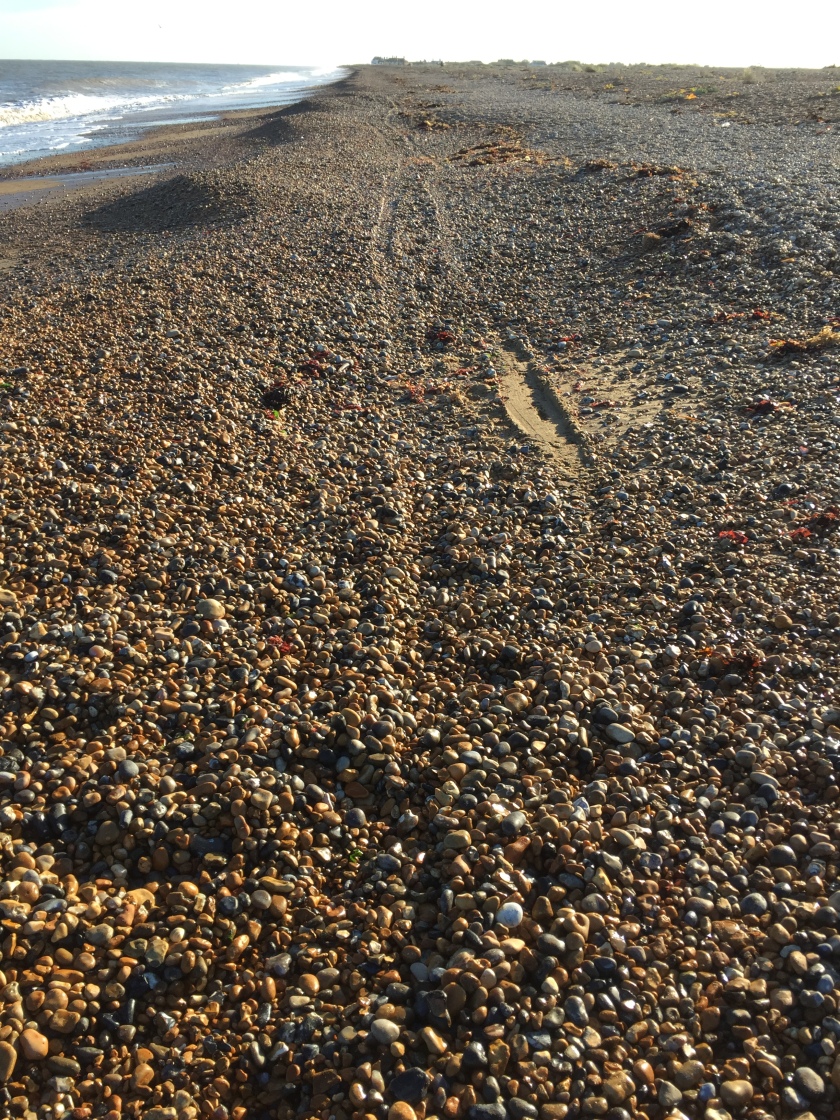
Sandwich Bay 4
The sledge glides easily over the pebbles and shingle. I had expected this to be hard, but the sledge seems made for this terrain. The tide isn’t very far out and the only sand showing is wet and cloying: it is almost impossible to drag the sledge on the saturated surface. I will stay on the shingle until I am nearer Shell Ness.
It is a gloriously bright day but the sea is rough and the waves sometimes shoot up to the shingle, moving around the sledge so that it is becoming a raft, weakly tied to the land by me.
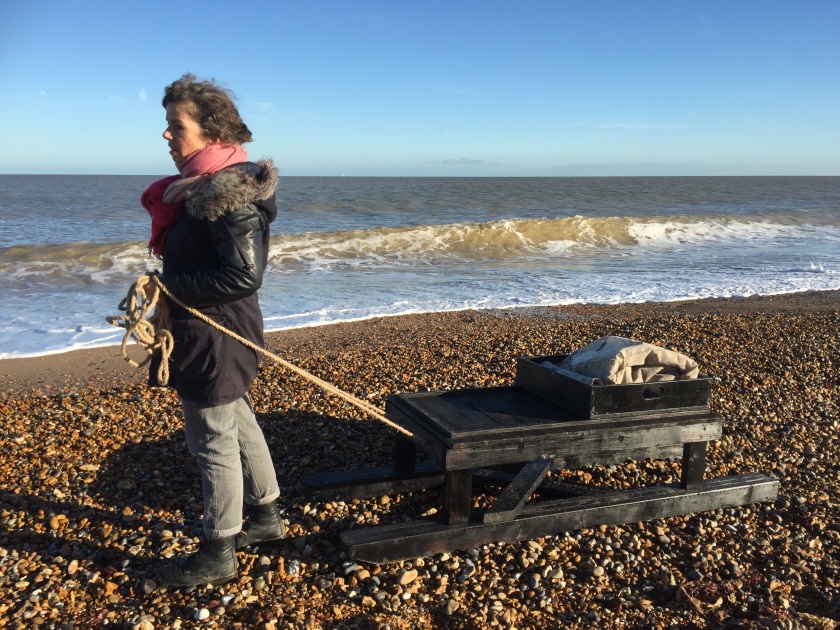
Sandwich Bay 5
Dusk. It is cold now, the sun has gone and I feel chilled. I resume dragging the sledge. Now that I have filled a box with sand and chalk stones it is heavier than ever. I crunch wearily over the bank of shells, lugging the sledge ever more slowly, until I reach the smoother sand. The distance back to the car looks interminable but I feel triumphant with my stash of materials. I have completed a major part of the Quest.
